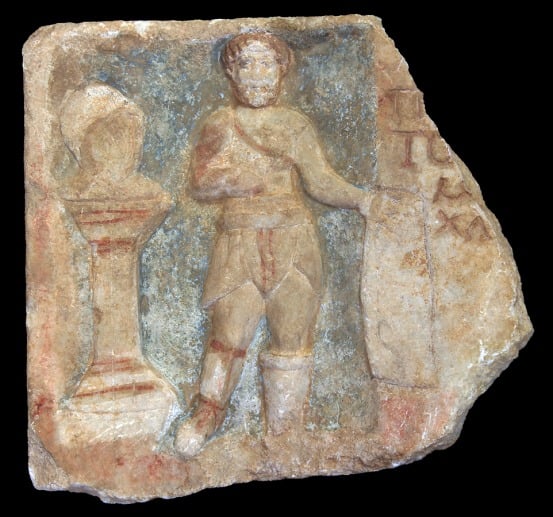
The mystery behind an ancient Roman funerary relief depicting a gladiator which has puzzled professionals at the Archaeological Museum of Thessaloniki for years has finally been solved.
The funerary relief stands out because some of the original colors remain preserved, whereas the colors on most sculptures dating back to antiquity have faded over the centuries.
Staff at the Museum of Thessaloniki recognized the importance of the artifact but were puzzled as to its origin. However, after years of research, they were finally able to determine where it came from.
Where did the Thessaloniki gladiator funerary relief come from?
“Until 2017, we could not identify its origin, that is, how it came to be in the museum’s collection. It had a serial number behind it, but it didn’t match ours,” commented Archaeologist Angeliki Koukouvou, head of the Department of Exhibitions, Communication and Education of the Archaeological Museum of Thessaloniki.
“So when an archival search was made in the archives of other services, it was finally located in a taxonomic number of the Byzantine museum,” continued the archaeologist. “So we found that it had been excavated in Konstantinou Melenikou Street, opposite the universities, near the eastern wall of ancient Thessaloniki.”
The funerary relief dates to the second half of the 2nd century AD and was dedicated to the gladiator it depicted. It may have been commissioned by the gladiator’s wife. Koukouvou further explained that the ancient city of Thessaloniki was the site of gladiatorial performances during the period of Roman rule.
“It is important because we have additional philological evidence that in Thessaloniki, as in other parts of the Roman world, the well-known duels and beast battles took place, a Roman spectacle that had come to all the eastern provinces of the Roman state.”
“The expenses were enormous and were always borne by the high priest of the imperial cult, that is, some very wealthy people with high positions, who were the great sponsors of the games and gave it as a gift to the people, who came to see them even from the countryside,” she added.
Details of the artifact
“Although not entirely intact, the excellent color preservation on the surface of the relief carries us to the vivid world of the arena and illuminates details of clothing and equipment that are difficult to distinguish in most stone reliefs,” notes the museum.
By examining the equipment depicted on the funerary relief, researchers were able to determine what style of fighting the gladiator was assigned to during his life.
The gladius sword, heavy round helmet, shield, manica (arm guard), and greave on the left leg indicate that this gladiator fought as a secutor. A secutor – meaning “chaser” or “pursuer” – was a heavily armored gladiator who was usually paired to fight against the retiarius, who fought with a trident and net.
See all the latest news from Greece and the world at Greekreporter.com. Contact our newsroom to report an update or send your story, photos and videos. Follow GR on Google News and subscribe here to our daily email!



